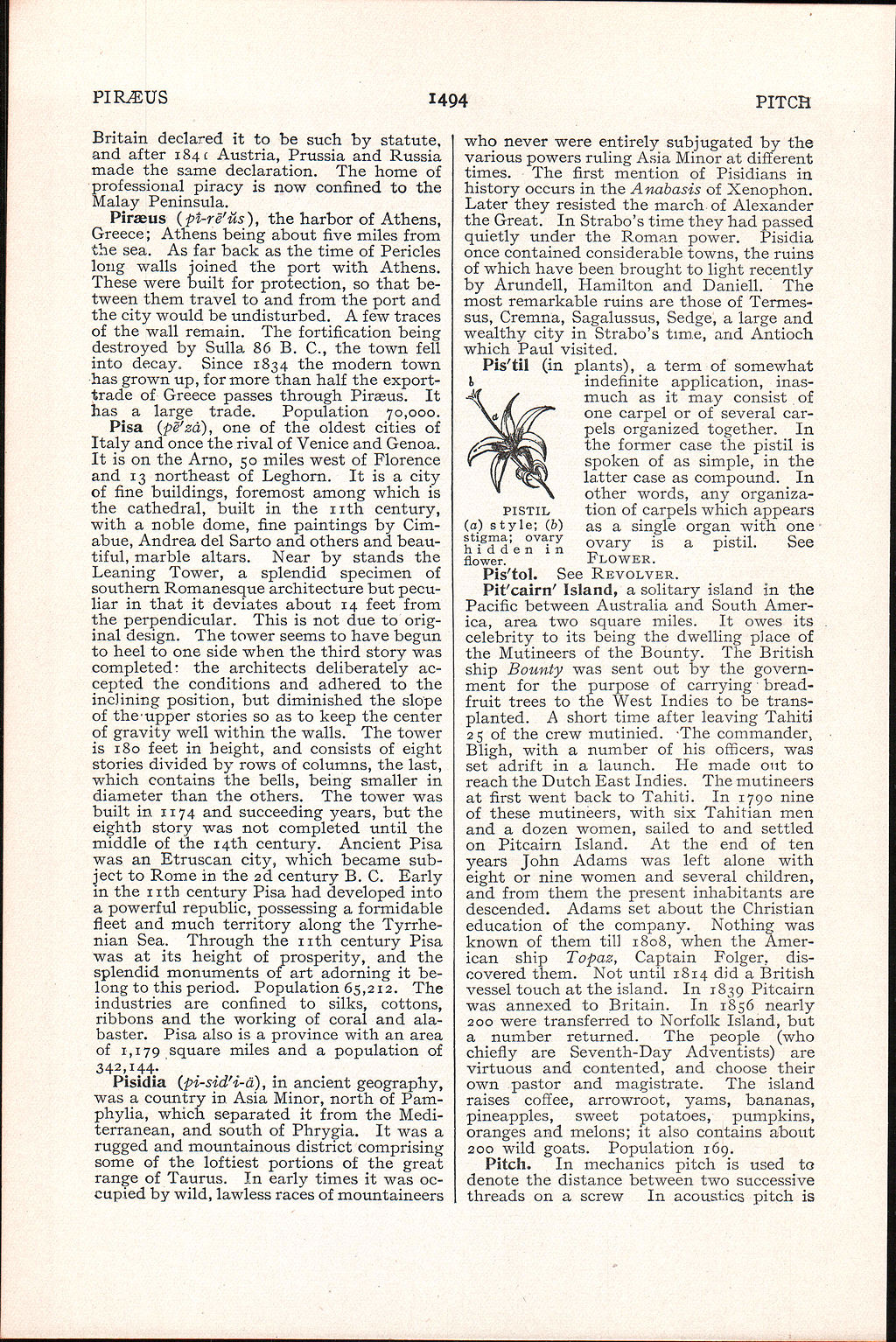PIR^US
1494
PITCH
Britain declared it to be such by statute, and after i84c Austria, Prussia and Russia made the same declaration. The home of professional piracy is now confined to the Malay Peninsula.
Piraeus (pi-re'us}, the harbor of Athens, Greece; Athens being about five miles from the sea. As far back as the time of Pericles long walls joined the port with Athens. These were built for protection, so that between them travel to and from the port and the city would be undisturbed. A few traces of the wall remain. The fortification being destroyed by Sulla 86 B. C., the town fell into decay. Since 1834 the modern town has grown up, for more than half the export-trade of Greece passes through Piraeus. It has a large trade. Population 70,000.
Pisa (pe'za), one of the oldest cities of Italy and once the rival of Venice and Genoa. It is on the Arno, 50 miles west of Florence and 13 northeast of Leghorn. It is a city of fine buildings, foremost among which is the cathedral, built in the nth century, with a noble dome, fine paintings by Cim-abue, Andrea del Sarto and others and beautiful, marble altars. Near by stands the Leaning Tower, a splendid specimen of southern Romanesque architecture but peculiar in that it deviates about 14 feet from the perpendicular. This is not due to original design. The tower seems to have begun to heel to one side when the third story was completed: the architects deliberately accepted the conditions and adhered to the inclining position, but diminished the slope of the-upper stories so as to keep the center of gravity well within the walls. The tower is 180 feet in height, and consists of eight stories divided by rows of columns, the last, which contains the bells, being smaller in diameter than the others. The tower was built in 1174 and succeeding years, but the eighth story was not completed until the middle of the i4th century. Ancient Pisa was an Etruscan city, which became subject to Rome in the 2d century B. C. Early in the nth century Pisa had developed into a powerful republic, possessing a formidable fleet and much territory along the Tyrrhenian Sea. Through the nth century Pisa was at its height of prosperity, and the splendid monuments of art _ adorning it belong to this period. Population 65,212. The industries are confined to silks, cottons, ribbons and the working of coral and alabaster. Pisa also is a province with an area of 1,179 square miles and a population of 342,144.
Pisidia (pi-sid'i-d), in ancient geography, was a country in Asia Minor, north of Pam-phylia, which separated it from the Mediterranean, and south of Phrygia. It was a rugged and mountainous district comprising some of the loftiest portions of the great range of Taurus. In early times it was occupied by wild, lawless races of mountaineers
PISTIL (a) style; (&)
stigma; ovary hidden in flower.
who never were entirely subjugated by the various powers ruling Asia Minor at different times. The first mention of Pisidians in history occurs in the Anabasis of Xenophon. Later they resisted the march of Alexander the Great. In Strabo's time they had passed quietly under the Roman power. Pisidia once contained considerable towns, the ruins of which have been brought to light recently by Arundell, Hamilton and Daniell. The most remarkable ruins are those of Termes-sus, Cremna, Sagalussus, Sedge, a large and wealthy city in Strabo's time, and Antioch which Paul visited,
Pis'til (in plants), a term of somewhat indefinite application, inasmuch as it may consist of one carpel or of several carpels organized together. In the former case the pistil is spoken of as simple, in the latter case as compound. In other words, any organization of carpels which appears as a single organ with one ovary is a pistil. See FLOWER.
Pis'tol. See REVOLVER. Pit'cairn' Island, a solitary island in the Pacific between Australia and South America, area two square miles. It owes its celebrity to its being the dwelling place of the Mutineers of the Bounty. The British ship Bounty was sent out by the government for the purpose of carrying breadfruit trees to the West Indies to be transplanted. A short time after leaving Tahiti 25 of the crew mutinied. -The commander > Bligh, with a number of his officers, was set adrift in a launch. He made out to reach the Dutch East Indies. The mutineers at first went back to Tahiti. In 1790 nine of these mutineers, with six Tahitian men and a dozen women, sailed to and settled on Pitcairn Island. At the end of ten years John Adams was left alone with eight or nine women and several children, and from them the present inhabitants are descended. Adams set about the Christian education of the company. Nothing was known of them till 1808, when the American ship Topaz, Captain Folger, discovered them. Not until 1814 did a British vessel touch at the island. In 1839 Pitcairn was annexed to Britain. In 1856 nearly 200 were transferred to Norfolk Island, but a number returned. The people (who chiefly are Seventh-Day Adventists) are virtuous and contented, and choose their own pastor and magistrate. The island raises coffee, arrowroot, yams, bananas, pineapples, sweet potatoes, pumpkins, oranges and melons; it also contains about 200 wild goats. Population 169.
Pitch. In mechanics pitch is used to denote the distance between two successive threads on a screw In acoustics pitch is
